Journal Description
Plasma
Plasma
is an international, open access, peer-reviewed journal covering all aspects of plasma science, published quarterly online by MDPI.
- Open Access— free for readers, with article processing charges (APC) paid by authors or their institutions.
- High Visibility: indexed within ESCI (Web of Science), Scopus, Inspec, CAPlus / SciFinder, and other databases.
- Rapid Publication: manuscripts are peer-reviewed and a first decision is provided to authors approximately 32.4 days after submission; acceptance to publication is undertaken in 4.2 days (median values for papers published in this journal in the second half of 2023).
- Recognition of Reviewers: reviewers who provide timely, thorough peer-review reports receive vouchers entitling them to a discount on the APC of their next publication in any MDPI journal, in appreciation of the work done.
Latest Articles
Recent Developments in the Use of Plasma in Medical Applications
Plasma 2024, 7(2), 284-299; https://doi.org/10.3390/plasma7020016 - 10 Apr 2024
Abstract
►
Show Figures
A detailed review of the scientific literature was undertaken to examine the most recent developments in plasma processing in the field of medicine. The first part of the review includes a detailed breakdown of the different types of coatings that can be applied
[...] Read more.
A detailed review of the scientific literature was undertaken to examine the most recent developments in plasma processing in the field of medicine. The first part of the review includes a detailed breakdown of the different types of coatings that can be applied onto medical devices using plasma, with a specific focus on antimicrobial surfaces. The developments in plasma-deposited biocompatibles, drug delivery and adhesive coatings in 2023 are described, and specific applications in additive manufacturing are highlighted. The use of plasma and plasma-activated liquids as standalone therapeutics continues to evolve, and pertinent advances in this field are described. In addition, the combination of plasma medicine with conventional pharmaceutical interventions is reviewed, and key emerging trends are highlighted, including the use of plasma to enhance drug delivery directly into tissue. The potential synergies between plasma medicine and chemotherapeutics for oncology and infection treatment are a growing area, and recent advancements are noted. Finally, the use of plasma to control excess antibiotics and to intentionally degrade such materials in waste streams is described.
Full article
Open AccessArticle
About the Data Analysis of Optical Emission Spectra of Reactive Ion Etching Processes—The Method of Spectral Redundancy Reduction
by
Micha Haase, Mudassir Ali Sayyed, Jan Langer, Danny Reuter and Harald Kuhn
Plasma 2024, 7(1), 258-283; https://doi.org/10.3390/plasma7010015 - 20 Mar 2024
Abstract
In this study, we present the Method of Spectral Redundancy Reduction (MSRR) for analyzing OES (optical emission spectroscopy) data of dry etching processes based on the principles of spectral clustering. To achieve this, the OES data are transformed into abstract graph matrices whose
[...] Read more.
In this study, we present the Method of Spectral Redundancy Reduction (MSRR) for analyzing OES (optical emission spectroscopy) data of dry etching processes based on the principles of spectral clustering. To achieve this, the OES data are transformed into abstract graph matrices whose associated eigenvectors directly indicate anomalies in the data set. We developed an approach that allows for the reduction in temporally resolved optical emission spectra from plasma structuring processes in such a way that individual emission lines can be algorithmically detected, which exhibit a temporal behavior different from the collective behavior of the temporally resolved overall spectrum. The proportion of emission lines that behave consistently throughout the entire process duration is not considered. Our work may find applications in which OES is used as a process-monitoring technique, especially for low-pressure plasma processing. The major benefit of the developed method is that the scale of the original data is kept, making physical interpretations possible despite data reductions.
Full article
(This article belongs to the Special Issue Feature Papers in Plasma Sciences 2023)
►▼
Show Figures
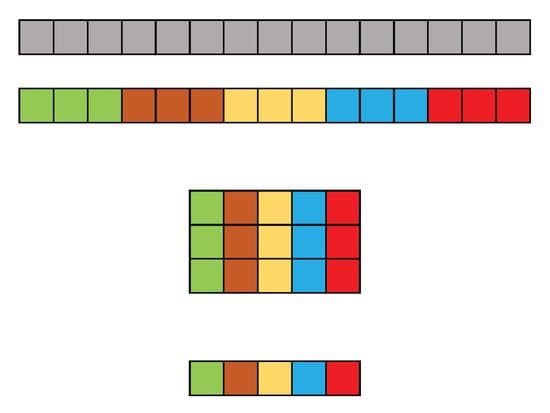
Figure 1
Open AccessReview
Cold Atmospheric Plasma Medicine: Applications, Challenges, and Opportunities for Predictive Control
by
Ali Kazemi, McKayla J. Nicol, Sven G. Bilén, Girish S. Kirimanjeswara and Sean D. Knecht
Plasma 2024, 7(1), 233-257; https://doi.org/10.3390/plasma7010014 - 16 Mar 2024
Abstract
Plasma medicine is an emerging field that applies the science and engineering of physical plasma to biomedical applications. Low-temperature plasma, also known as cold plasma, is generated via the ionization of atoms in a gas, generally via exposure to strong electric fields, and
[...] Read more.
Plasma medicine is an emerging field that applies the science and engineering of physical plasma to biomedical applications. Low-temperature plasma, also known as cold plasma, is generated via the ionization of atoms in a gas, generally via exposure to strong electric fields, and consists of ions, free radicals, and molecules at varying energy states. Plasmas generated at low temperatures (approximately room temperature) have been used for applications in dermatology, oncology, and anti-microbial strategies. Despite current and ongoing clinical use, the exact mechanisms of action and the full range of effects of cold plasma treatment on cells are only just beginning to be understood. Direct and indirect effects of plasma on immune cells have the potential to be utilized for various applications such as immunomodulation, anti-infective therapies, and regulating inflammation. In this review, we combine diverse expertise in the fields of plasma chemistry, device design, and immunobiology to cover the history and current state of plasma medicine, basic plasma chemistry and their implications, the effects of cold atmospheric plasma on host cells with their potential immunological consequences, future directions, and the outlook and recommendations for plasma medicine.
Full article
(This article belongs to the Special Issue Latest Review Papers in Plasma Science 2023)
►▼
Show Figures
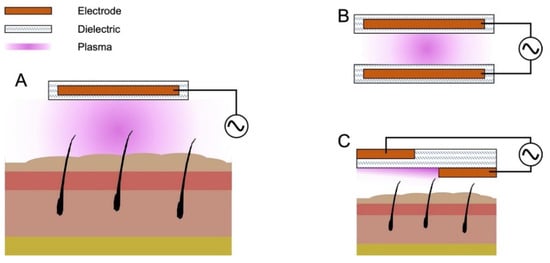
Figure 1
Open AccessReview
Optimal Conditions for the Generation of Runaway Electrons in High-Pressure Gases
by
Andrey Kozyrev and Victor Tarasenko
Plasma 2024, 7(1), 201-232; https://doi.org/10.3390/plasma7010013 - 15 Mar 2024
Abstract
Runaway electron (RAE) generation in high-pressure gases is an important physical phenomenon that significantly influences discharge shapes and properties of initiated plasma. The diffuse discharges formed due to RAEs in the air and other gases at atmospheric pressure find wide applications. In the
[...] Read more.
Runaway electron (RAE) generation in high-pressure gases is an important physical phenomenon that significantly influences discharge shapes and properties of initiated plasma. The diffuse discharges formed due to RAEs in the air and other gases at atmospheric pressure find wide applications. In the present review, theoretical and experimental results that explain the reason for RAE occurrence at high pressures are analyzed, and recommendations are given for the implementation of conditions under which the runaway electron beam (RAEB) with the highest current can be obtained at atmospheric pressure. The experimental results were obtained using subnanosecond, nanosecond, and submicrosecond generators, including those specially developed for runaway electron generation. The RAEBs were recorded using oscilloscopes and collectors with picosecond time resolution. To theoretically describe the phenomenon of continuous electron acceleration, the method of physical kinetics was used based on the Boltzmann kinetic equation that takes into account the minimum but sufficient number of elementary processes, including shock gas ionization and elastic electron scattering. The results of modeling allowed the main factors to be established that control the RAE appearance, the most important of which is electron scattering on neutral atoms and/or molecules. Theoretical modeling has allowed the influence of various parameters (including the voltage, pressure, gas type, and geometrical characteristics of the discharge gap) to be taken into account. The results of the research presented here allow RAE accelerators with desirable parameters to be developed and the possibility of obtaining diffuse discharges to be accessed under various conditions. The review consists of the Introduction, five sections, the Conclusion, and the References.
Full article
(This article belongs to the Special Issue Latest Review Papers in Plasma Science 2023)
►▼
Show Figures
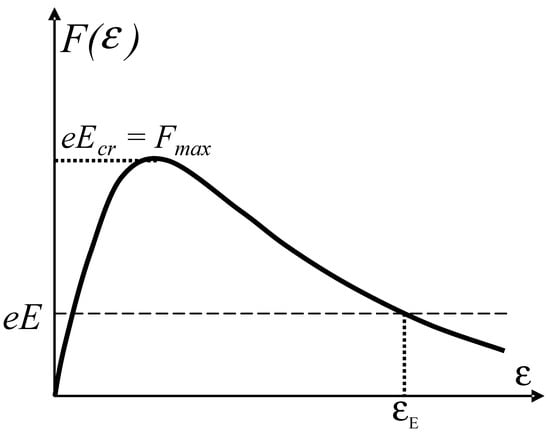
Figure 1
Open AccessArticle
Practical Model for the Calculation of Lateral Electromagnetic Loads in Tokamaks at Asymmetric Vertical Displacement Events (AVDEs)
by
Sergey Sadakov, Fabio Villone, Daniel Iglesias, Luis Maqueda, Jesus Almenara-Rescalvo, Guglielmo Rubinacci and Salvatore Ventre
Plasma 2024, 7(1), 178-200; https://doi.org/10.3390/plasma7010012 - 13 Mar 2024
Abstract
This paper describes a new practical numerical model for the calculation of lateral electromagnetic (EM) loads in tokamaks during asymmetric vertical displacement events (AVDEs). The model combines key features of two recently reported trial models while avoiding their drawbacks. Their common basic feature
[...] Read more.
This paper describes a new practical numerical model for the calculation of lateral electromagnetic (EM) loads in tokamaks during asymmetric vertical displacement events (AVDEs). The model combines key features of two recently reported trial models while avoiding their drawbacks. Their common basic feature is the superposition of two patterns of halo current: one perfectly symmetric and another perfectly anti-symmetric. This model combines the following features that have not been combined before (a) a helically distorted halo layer wrapping around core plasma, and (b) halo-to-wall interception belts slipping along plasma-facing walls. This combination almost doubles the lateral net forces. An AVDE creates significant lateral net moments. Being relatively modest at VDEs, the lateral moments become a dominant component of EM loads at AVDEs. The model carefully tracks the balance of net EM loads (zero total for the tokamak), as a necessary condition for the consequent numerical simulation of the tokamak’s dynamic response. This balance is needed as well for the development of tokamak monitoring algorithms and simulators. In order to decouple from the current uncertainties in the interpretation and simulation of AVDE physics, the model does not simulate AVDE evolution but uses it as an input assumption based on the existing interpretation and simulation of AVDE physics. This means the model is to be used in a manner of parametric study, at widely varied input assumptions on AVDE evolution and severity. Parametric results will fill a library of ready-for-use waveforms of asymmetric EM loads (distributed and total) at tokamak structures and coils, so that the physics community may point to specific variants for subsequent engineering analysis. This article presents the first practical contribution to this AVDE library.
Full article
(This article belongs to the Special Issue Feature Papers in Plasma Sciences 2023)
►▼
Show Figures

Figure 1
Open AccessReview
Plasma-Driven Sciences: Exploring Complex Interactions at Plasma Boundaries
by
Kenji Ishikawa, Kazunori Koga and Noriyasu Ohno
Plasma 2024, 7(1), 160-177; https://doi.org/10.3390/plasma7010011 - 27 Feb 2024
Abstract
Plasma-driven science is defined as the artificial control of physical plasma-driven phenomena based on complex interactions between nonequilibrium open systems. Recently, peculiar phenomena related to physical plasma have been discovered in plasma boundary regions, either naturally or artificially. Because laboratory plasma can be
[...] Read more.
Plasma-driven science is defined as the artificial control of physical plasma-driven phenomena based on complex interactions between nonequilibrium open systems. Recently, peculiar phenomena related to physical plasma have been discovered in plasma boundary regions, either naturally or artificially. Because laboratory plasma can be produced under nominal conditions around atmospheric pressure and room temperature, phenomena related to the interaction of plasma with liquid solutions and living organisms at the plasma boundaries are emerging. Currently, the relationships between these complex interactions should be solved using science-based data-driven approaches; these approaches require a reliable and comprehensive database of dynamic changes in the chemical networks of elementary reactions. Consequently, the elucidation of the mechanisms governing plasma-driven phenomena and the discovery of the latent actions behind these plasma-driven phenomena will be realized through plasma-driven science.
Full article
(This article belongs to the Special Issue Latest Review Papers in Plasma Science 2023)
►▼
Show Figures
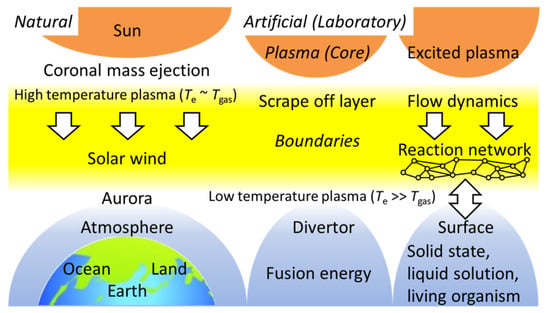
Figure 1
Open AccessReview
A Physical Metric for Inertial Confinement Fusion Capsules
by
Baolian Cheng and Paul A. Bradley
Plasma 2024, 7(1), 146-159; https://doi.org/10.3390/plasma7010010 - 21 Feb 2024
Abstract
►▼
Show Figures
The performance of fusion capsules on the National Ignition Facility (NIF) is strongly affected by the physical properties of the hot deuterium–tritium (DT) fuel, such as the mass, areal density, and pressure of the hot spot at the stagnation time. All of these
[...] Read more.
The performance of fusion capsules on the National Ignition Facility (NIF) is strongly affected by the physical properties of the hot deuterium–tritium (DT) fuel, such as the mass, areal density, and pressure of the hot spot at the stagnation time. All of these critical quantities depend on one measured quantity, which is the ratio of the specific peak implosion energy to the specific internal energy of the hot spot. This unique physical quantity not only can measure the incremental progress of the inertial confinement fusion capsules towards ignition but also measures the conversion of the peak implosion kinetic energy of the pusher shell into the internal energy of the hot fuel in a capsule. Analysis of existing NIF shots to date are performed. The ratio metric is compared quantitatively with the ignition criterion. Results provide new perspectives on the NIF experiments by which the performance of the burning plasma can be determined and controlled through the fine tune of the implosion parameters, which improves future designs and predictions of the ignition capsules.
Full article
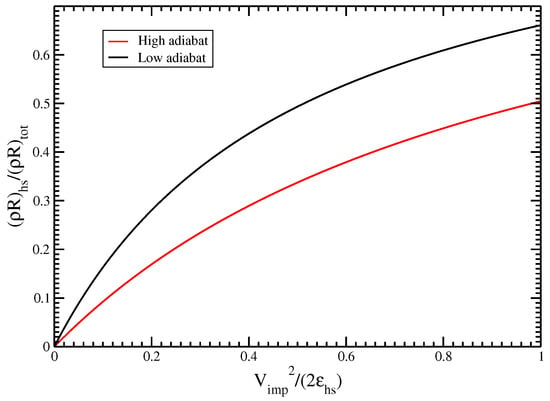
Figure 1
Open AccessReview
Particle Propagation and Electron Transport in Gases
by
Luca Vialetto, Hirotake Sugawara and Savino Longo
Plasma 2024, 7(1), 121-145; https://doi.org/10.3390/plasma7010009 - 16 Feb 2024
Cited by 1
Abstract
►▼
Show Figures
In this review, we detail the commonality of mathematical intuitions that underlie three numerical methods used for the quantitative description of electron swarms propagating in a gas under the effect of externally applied electric and/or magnetic fields. These methods can be linked to
[...] Read more.
In this review, we detail the commonality of mathematical intuitions that underlie three numerical methods used for the quantitative description of electron swarms propagating in a gas under the effect of externally applied electric and/or magnetic fields. These methods can be linked to the integral transport equation, following a common thread much better known in the theory of neutron transport than in the theory of electron transport. First, we discuss the exact solution of the electron transport problem using Monte Carlo (MC) simulations. In reality we will go even further, showing the interpretative role that the diagrams used in quantum theory and quantum field theory can play in the development of MC. Then, we present two methods, the Monte Carlo Flux and the Propagator method, which have been developed at this moment. The first one is based on a modified MC method, while the second shows the advantage of explicitly applying the mathematical idea of propagator to the transport problem.
Full article
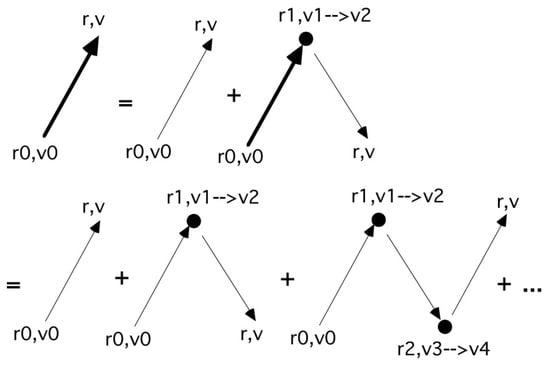
Figure 1
Open AccessArticle
Rapid Access to Empirical Impact Ionization Cross Sections for Atoms and Ions across the Periodic Table
by
Stephan Fritzsche, Liguang Jiao and Giorgio Visentin
Plasma 2024, 7(1), 106-120; https://doi.org/10.3390/plasma7010008 - 30 Jan 2024
Abstract
Electron-impact ionization (EII) processes are essential for modelling high-temperature plasma in quite different research areas, from astrophysics to material science to plasma and fusion research and in several places elsewhere. In most, if not all, of these fields, partial and total EII cross
[...] Read more.
Electron-impact ionization (EII) processes are essential for modelling high-temperature plasma in quite different research areas, from astrophysics to material science to plasma and fusion research and in several places elsewhere. In most, if not all, of these fields, partial and total EII cross sections are required, and often for a good range of electron energies, in order to determine, for instance, the level population of ions and spectral line intensities in plasma under both local and non-local thermodynamic equilibrium conditions. To obey these needs, various kinds of semi-empirical EII cross sections have been applied in practice, often simply because of the large computational demands in dealing explicitly with two free electrons within the continuum. Here, we expand Jac, the Jena Atomic Calculator, to provide such empirical EII cross sections for (most) atoms and ions across the periodic table. Five empirical models from the recent literature have been implemented to support a simple and rapid access to the partial EII cross sections for electrons from a (partly filled) shell
(This article belongs to the Special Issue Feature Papers in Plasma Sciences 2023)
►▼
Show Figures
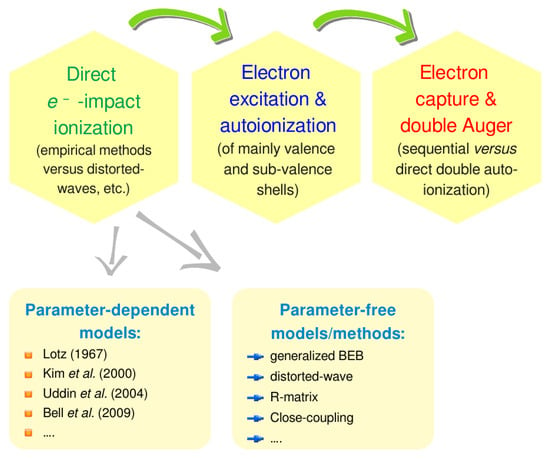
Figure 1
Open AccessArticle
Plasma Treatment of Different Biodegradable Polymers: A Method to Enhance Wettability and Adhesion Properties for Use in Industrial Packaging
by
Espedito Vassallo, Matteo Pedroni, Marco Aloisio, Silvia Maria Pietralunga, Riccardo Donnini, Francesca Saitta and Dimitrios Fessas
Plasma 2024, 7(1), 91-105; https://doi.org/10.3390/plasma7010007 - 26 Jan 2024
Abstract
►▼
Show Figures
Biodegradable polymers (poly(butylene succinate (PBS)), poly(butylene adipate terephthalate (PBAT)) and poly(lactic acid)/poly(butylene adipate terephthalate (PLA/PBAT)) blend) were treated in radiofrequency (13.56 MHz) low-pressure (10 Pa) oxygen with argon post-crosslinking plasma to enhance wettability and adhesion properties. Surface morphology and roughness modification caused by
[...] Read more.
Biodegradable polymers (poly(butylene succinate (PBS)), poly(butylene adipate terephthalate (PBAT)) and poly(lactic acid)/poly(butylene adipate terephthalate (PLA/PBAT)) blend) were treated in radiofrequency (13.56 MHz) low-pressure (10 Pa) oxygen with argon post-crosslinking plasma to enhance wettability and adhesion properties. Surface morphology and roughness modification caused by plasma exposure were observed by scanning electron microscopy (SEM) and atomic force microscopy (AFM). Surface chemical modifications of plasma-treated samples were evaluated by Fourier Transform infrared spectroscopy (FTIR). Due to the limited durability of plasma activation, the hydrophobic recovery was evaluated by water contact angle (WCA) measurements. The ageing effect was measured over 15 days in order to assess this kind of treatment as a potential industrial scalable method to increase biodegradable polymers hydrophilic properties for food packaging applications. The effects of polymer activation on its weight loss were also determined. Differential scanning calorimetry (DSC) analysis was used to study the effect of plasma treatment on the thermal properties of the polymers, while the crystallinity was investigated by X-ray diffraction (XRD).
Full article
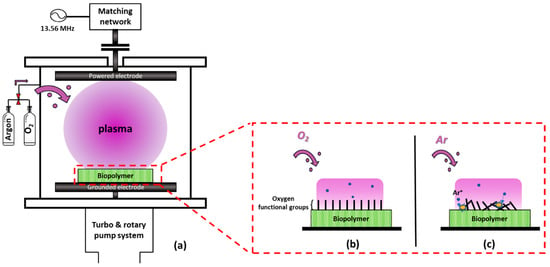
Figure 1
Open AccessArticle
Thermal Plasma Spheroidization and Characterization of Stainless Steel Powders Using Direct Current Plasma Technology
by
Pierpaolo Iovane, Carmela Borriello, Giuseppe Pandolfi, Sabrina Portofino, Gabriella Rametta, Loredana Tammaro, Nicola Fedele and Sergio Galvagno
Plasma 2024, 7(1), 76-90; https://doi.org/10.3390/plasma7010006 - 23 Jan 2024
Abstract
The production of spherical powders has recently registered a boost due to the need to fabricate new printing materials for Additive Manufacturing applications, from polymers and resins to metals and ceramics. Among these materials, stainless steels powders play a leading role, since they
[...] Read more.
The production of spherical powders has recently registered a boost due to the need to fabricate new printing materials for Additive Manufacturing applications, from polymers and resins to metals and ceramics. Among these materials, stainless steels powders play a leading role, since they are widely used in industry and everyday life; indeed, micron-sized spherical stainless steel powders have specific characteristics and are considered as one of the best candidates for Additive Manufacturing systems and for application in a wide range of sectors. In this paper, stainless steel 316 L powders were used to explore and identify the best process parameters of a thermal plasma process able to produce spherical powders for Additive Manufacturing applications. X-ray Diffraction, Scanning Electron Microscopy, Particle Size Distribution and Flowability analysis were performed to characterize reagents and products. Powders with a high circularity (>0.8) and improved flowability (<30 s/50 g) were successfully obtained. The collected results were compared with data available from the literature to identify the potential use of the spherical produced powders.
Full article
(This article belongs to the Special Issue Feature Papers in Plasma Sciences 2023)
►▼
Show Figures

Figure 1
Open AccessArticle
Spatial Distribution Analyses of Axially Long Plasmas under a Multi-Cusp Magnetic Field Using a Kinetic Particle Simulation Code KEIO-MARC
by
Ryota Nishimura, Tomohiro Seino, Keigo Yoshimura, Hiroyuki Takahashi, Akinobu Matsuyama, Kazuo Hoshino, Tetsutarou Oishi and Kenji Tobita
Plasma 2024, 7(1), 64-75; https://doi.org/10.3390/plasma7010005 - 22 Jan 2024
Abstract
To realize the development of a long plasma source with a uniform electron density distribution in the axial direction, the spatial distribution of plasma under a multi-cusp magnetic field was analyzed using a KEIO-MARC code. Considering a cylindrical plasma source with an axial
[...] Read more.
To realize the development of a long plasma source with a uniform electron density distribution in the axial direction, the spatial distribution of plasma under a multi-cusp magnetic field was analyzed using a KEIO-MARC code. Considering a cylindrical plasma source with an axial length of 3000 mm and a cross-sectional diameter of 100 mm, in which the filament electrode was the electron source, the electron density distribution was calculated using the residual magnetic flux density, Bres, and the number of permanent magnets installed at different locations surrounding the device, Nmag, as design parameters. The results show that both Bres and Nmag improved the uniformity of the electron density distribution in the axial direction. The maximum axial electron density decreased with increasing Nmag and increased with increasing Bres. These trends can be explained by considering the nature of the multi-cusp field, where particles are mainly confined to the field-free region (FFR) near the center of the plasma column, and the loss of particles due to radial particle transport. The use of multiple filaments at intervals shorter than the plasma decay length dramatically improved axial uniformity. To further improve axial uniformity, the filament length and FFR must be properly set so that electrons are emitted inside the FFR.
Full article
(This article belongs to the Special Issue New Insights into Plasma Theory, Modeling and Predictive Simulations)
►▼
Show Figures
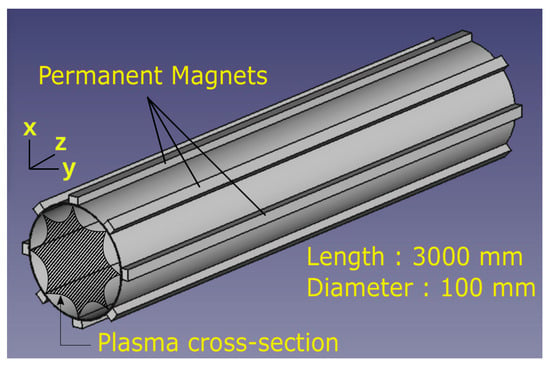
Figure 1
Open AccessArticle
Polystyrene (PS) Degradation Induced by Nanosecond Electric Discharge in Air in Contact with PS/Water
by
Aurélie Zamo, Catherine Rond and Ahmad Hamdan
Plasma 2024, 7(1), 49-63; https://doi.org/10.3390/plasma7010004 - 16 Jan 2024
Abstract
Water pollution with microplastics has become a significant concern. Conventional treatment methods have proven ineffective, and alternatives are being explored. Herein, we assess the degradation efficiency of polystyrene (PS) by measuring its nanosecond discharge in air in contact with water. Its discharge is
[...] Read more.
Water pollution with microplastics has become a significant concern. Conventional treatment methods have proven ineffective, and alternatives are being explored. Herein, we assess the degradation efficiency of polystyrene (PS) by measuring its nanosecond discharge in air in contact with water. Its discharge is characterized during processing, and a transition from streamer-like to spark-like discharge occurs due to the increased electrical conductivity of water. Experiments are conducted at different frequencies, and the highest degradation is achieved at 10 kHz; an 83% polystyrene weight loss is recorded after 5 min of processing. The optical spectra of the discharge show no evidence of C-species, and an FTIR analysis of the processed polystyrene reveals no structural modifications. An NMR analysis shows the presence of ethylbenzene in water. Finally, a mechanism of PS degradation is proposed.
Full article
(This article belongs to the Special Issue Processes in Atmospheric Pressure Plasmas)
►▼
Show Figures

Figure 1
Open AccessReview
A Tutorial on the One-Dimensional Theory of Electron-Beam Space-Charge Effect and Steady-State Virtual Cathode
by
Weihua Jiang
Plasma 2024, 7(1), 29-48; https://doi.org/10.3390/plasma7010003 - 05 Jan 2024
Cited by 1
Abstract
The space-charge effects of pulsed high-current electron beams are very important to high-power particle beam accelerators and high-power microwave devices. The related physical phenomena have been studied for decades, and a large number of informative publications can be found in numerous scientific journals
[...] Read more.
The space-charge effects of pulsed high-current electron beams are very important to high-power particle beam accelerators and high-power microwave devices. The related physical phenomena have been studied for decades, and a large number of informative publications can be found in numerous scientific journals over many years. This review article is aimed at systematically summarizing most of the previous findings in a logical manner. Using a normalized one-dimensional mathematical model, analytical solutions have been obtained for the space-charge-limited current of both planar diode and drifting space. In addition, in the case of a beam current higher than the space-charge-limited current, the virtual cathode behavior and beam current reflection are quantitively studied. Furthermore, the criteria of steady-state virtual cathode formation are investigated, which leads to the physical understanding of the unstable nature of the virtual cathode. This review article is expected to serve as an integrated source of related information for young researchers and students working on high-power microwaves and pulsed particle beams.
Full article
(This article belongs to the Special Issue Latest Review Papers in Plasma Science 2023)
►▼
Show Figures
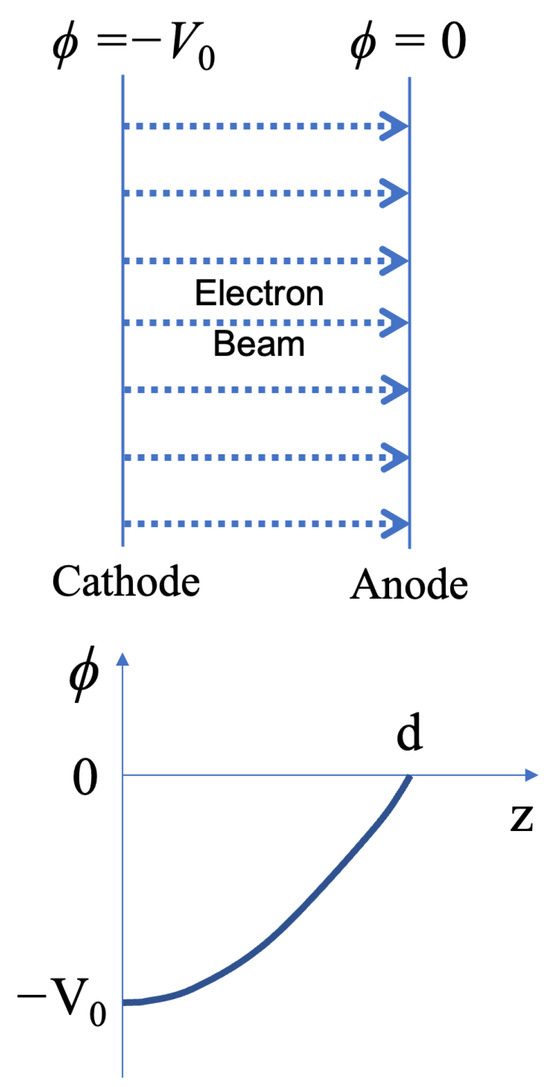
Figure 1
Open AccessArticle
Effects of Non-Thermal Plasma on the Transition from Nano-Crystalline to Amorphous Structure in Water and Subsequent Effects on Viscosity
by
Joshua Ginzburg, Mobish Shaji, Alexander Rabinovich, Dmitri Vainchtein, Christopher Sales and Alexander Fridman
Plasma 2024, 7(1), 16-28; https://doi.org/10.3390/plasma7010002 - 21 Dec 2023
Abstract
Recent studies have demonstrated that the physical properties of water treated with non-thermal plasma, or plasma-activated water (PAW), significantly differ from those of distilled water. For example, contrary to expectation, the viscosity of PAW becomes lower than that of distilled water at certain
[...] Read more.
Recent studies have demonstrated that the physical properties of water treated with non-thermal plasma, or plasma-activated water (PAW), significantly differ from those of distilled water. For example, contrary to expectation, the viscosity of PAW becomes lower than that of distilled water at certain temperatures. This study developed a model to explain these differences by combining the two-state model of ordinary water, which describes water as a combination of nano-crystalline clusters and amorphous, free-floating molecules, using the Debye–Huckel theory for a fluid containing ions. A model for the viscosity of PAW was then developed from the general model. It explains how PAW has a lower viscosity than distilled water as the temperature decreases and why this effect is stronger than the colligative effect for ideal solutions. Finally, the viscosity model is compared to the experimental measurements of PAW treated with gliding arc plasma, showing that the data match the predicted values quite well. The model of PAW developed here can be used to understand other physical properties beyond viscosity, such as the surface tension, contact angle, electric conductivity, heat capacity, isothermal compressibility, and density, potentially facilitating new applications of PAW.
Full article
(This article belongs to the Special Issue New Insights into Plasma Theory, Modeling and Predictive Simulations)
►▼
Show Figures
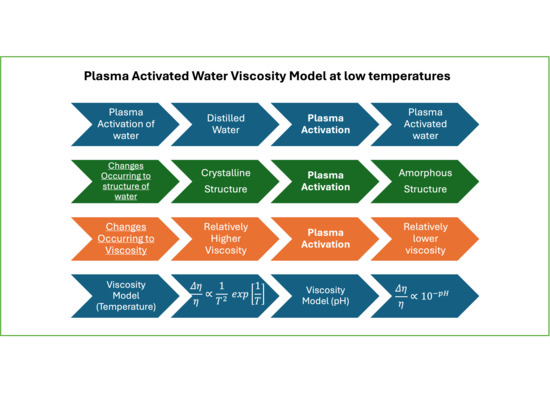
Graphical abstract
Open AccessArticle
A Semi-Empirical Model of Cathodic Arc Spot Motion under the Influence of External Magnetic Fields
by
Achim Mahrle, Otmar Zimmer, Steffen Schenk, Madlen Borkmann and Christoph Leyens
Plasma 2024, 7(1), 1-15; https://doi.org/10.3390/plasma7010001 - 19 Dec 2023
Abstract
Plasma generation by cathodic arc spots plays a crucial role for coating processes that make use of the Arc-PVD technology. Usually, the arc spot motion over the cathode is steered by a magnetic field of a particular distribution and magnitude to ensure a
[...] Read more.
Plasma generation by cathodic arc spots plays a crucial role for coating processes that make use of the Arc-PVD technology. Usually, the arc spot motion over the cathode is steered by a magnetic field of a particular distribution and magnitude to ensure a continuous plasma generation, the avoidance of liquid droplets, and a proper utilization of cathode material by homogeneous erosion. This study presents a semi-empirical model that allows for an examination and characterization of the arc spot motion with regard to direction and speed as a function of an imposed magnetic field. This model considers the different components of random walk, retrograde, and Robson drift motion. Introduced empirical coefficients were determined by corresponding experimental investigations. The calibrated model describes the arc spot motion in good agreement to the recorded spot tracks and can therefore be applied for an evaluation of different magnetic field configurations.
Full article
(This article belongs to the Special Issue Feature Papers in Plasma Sciences 2023)
►▼
Show Figures
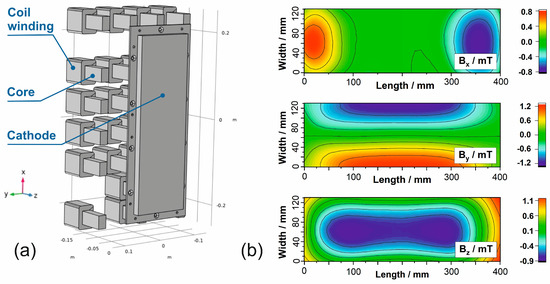
Figure 1
Open AccessArticle
Pulsed Dielectric Barrier Discharges for Gas-Phase Composition Control: A Simulation Model
by
Ruggero Barni, Prince Alex and Claudia Riccardi
Plasma 2023, 6(4), 735-752; https://doi.org/10.3390/plasma6040050 - 12 Dec 2023
Cited by 1
Abstract
We present results obtained from the numerical simulation of the gas-phase chemical kinetics in atmospheric pressure air non-equilibrium plasmas. In particular, we addressed the effect of the pulsed operation mode of a planar dielectric barrier discharge. As conjectured, the large difference in the
[...] Read more.
We present results obtained from the numerical simulation of the gas-phase chemical kinetics in atmospheric pressure air non-equilibrium plasmas. In particular, we addressed the effect of the pulsed operation mode of a planar dielectric barrier discharge. As conjectured, the large difference in the time scales involved in the fast dissociation of molecules in plasmas and their subsequent reactions to produce stable chemical species makes the presence of a continuously repeated plasma production stage unnecessary and a waste of electrical power and efficiency. The results on NOx remediation, ozone production, water vapor and ammonia dissociation are discussed. A few comparisons with experimental findings in a dielectric barrier discharge reactor already used for applications are also briefly addressed. Our results clearly indicate a pattern for the optimization of the discharge using a carefully designed repetition rate and duty cycle.
Full article
(This article belongs to the Special Issue Dielectric Barrier Discharges 2023)
►▼
Show Figures
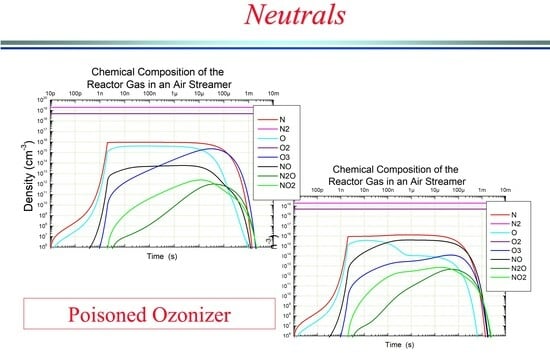
Graphical abstract
Open AccessArticle
Experimental Progress in the Development of a Metal Foil Pump for DEMO
by
Yannick Kathage, Alejandro Vazquez Cortes, Stefan Merli, Christian Day, Thomas Giegerich, Stefan Hanke, Juri Igitkhanov, Andreas Schulz and Matthias Walker
Plasma 2023, 6(4), 714-734; https://doi.org/10.3390/plasma6040049 - 28 Nov 2023
Cited by 1
Abstract
Experimental findings to contribute to the preliminary design of a metal foil pump for fuel separation in the Direct Internal Recycling loop of the DEMO fusion device are presented. In parametric studies on a small-scale superpermeation experiment with a microwave plasma source and
[...] Read more.
Experimental findings to contribute to the preliminary design of a metal foil pump for fuel separation in the Direct Internal Recycling loop of the DEMO fusion device are presented. In parametric studies on a small-scale superpermeation experiment with a microwave plasma source and two different metal foil materials, niobium Nb and vanadium V, a substantial increase in permeation with plasma power and with a decrease in pressure was observed. To ease operation in the typical fusion environment, in-situ heating procedures were developed to recover from impurity contamination. The temperature independence of plasma-driven permeation from 600 to 900 °C metal foil temperature was demonstrated. No proof of an isotopic effect for plasma-driven permeation of protium and deuterium could be found. The highest repeatable permeation flux achieved was 6.7 Pa∙m3/(m2∙s) or ~5.5 × 10−3 mol H/(m2∙s). The found compression ratios do safely allow the operation of the metal foil pump using ejector pumps as backing stages for the permeate. In a dedicated experimental setup, the operation of the plasma source in a strong magnetic field was tested. Parametric studies of pressure, power input, magnetic flux density, field gradient and field angle are presented.
Full article
(This article belongs to the Special Issue Feature Papers in Plasma Sciences 2023)
►▼
Show Figures

Graphical abstract
Open AccessArticle
Generation of Plasma-Activated Fluids for Successful Disinfection of Pseudomonas aeruginosa in Liquid Environments and Determination of Microbial Damage
by
Mareike Hummert, Paul Leenders, Alexander Mellmann, Karsten Becker and Thorsten Kuczius
Plasma 2023, 6(4), 699-713; https://doi.org/10.3390/plasma6040048 - 21 Nov 2023
Cited by 1
Abstract
The application of the non-thermal atmospheric pressure plasma technology is a promising tool for microbial inactivation. During the activation process, many reactive substances and radicals arise associated with physicochemical changes in the fluid and massive pH drop. In this study, we analyzed and
[...] Read more.
The application of the non-thermal atmospheric pressure plasma technology is a promising tool for microbial inactivation. During the activation process, many reactive substances and radicals arise associated with physicochemical changes in the fluid and massive pH drop. In this study, we analyzed and optimized plasma activation settings and conditions of water and liquids to obtain inactivation of the waterborne microorganism Pseudomonas aeruginosa in a liquid environment. The minimal electrical output was 60 Watt with 20 min activation time followed by 30 min contact time with 108 cells/mL. Using higher electrical power (>90 W) with a Lab Unit generating plasma-activated water, a shorter activation time (<10 min) was sufficient for bacterial inactivation. The organic and inorganic composition of the activated liquid with different mineral salt concentrations is of utmost importance for the yield of reactive species during the plasma activation process and consequently for the antimicrobial effect. Plasma-activated fluids with high organic and inorganic contents demonstrated lower inactivation efficiencies than low loaded fluids; yet antimicrobial efficacy could be achieved by increasing the electrical power and activation time. For sufficient inactivation of bacterial suspensions, at least half a volume unit of plasma-activated water had to be added after appropriately optimized activation. Further dilutions reduced the antimicrobial effect. PAW lost activity after being left standing for a prolonged time after activation, so for maximizing the antimicrobial effect a direct use after activation is recommendable. Bacterial inactivation was shown by the absence of colony forming units on culture media and, at the molecular level, damage to the membrane and inactivation of enzymes were observed. Plasma-activated fluids demonstrated a high potential in applications as microbiological disinfectant in liquids.
Full article
(This article belongs to the Special Issue Feature Papers in Plasma Sciences 2023)
►▼
Show Figures

Figure 1
Open AccessArticle
Influence of Voltage, Pulselength and Presence of a Reverse Polarized Pulse on an Argon–Gold Plasma during a High-Power Impulse Magnetron Sputtering Process
by
Jürgen Guljakow and Walter Lang
Plasma 2023, 6(4), 680-698; https://doi.org/10.3390/plasma6040047 - 20 Nov 2023
Abstract
This work aims to provide information about the deposition of gold via bipolar high-power impulse magnetron sputtering (HIPIMS) in order to identify suitable process parameters. The influences of voltage, pulse length and the kick-pulse on an argon–gold plasma during a bipolar high-power impulse
[...] Read more.
This work aims to provide information about the deposition of gold via bipolar high-power impulse magnetron sputtering (HIPIMS) in order to identify suitable process parameters. The influences of voltage, pulse length and the kick-pulse on an argon–gold plasma during a bipolar high-power impulse magnetron sputtering deposition process were analysed via optical emission spectroscopy (OES) and oscilloscope. The voltage was varied between 700 V and 1000 V, the pulse length was varied between 20 µs and 100 µs and the process was observed once with kick-pulse and once without. The influence of the voltage on the plasma was more pronounced than the influence of the pulse width. While the intensity of several Au I lines increased up to 13-fold with increasing voltages, only a less-than linear increase in Au I brightness with time could be identified for changes in pulse length. The intensity of excited argon is only minimally affected by changes in voltages, but follows the evolution of the discharge current, with increasing pulse lengths. Contrary to the excited argon, the intensity emitted by ionized argon grows nearly linearly with voltage and pulse length. The reverse polarised pulse mainly affects the excited argon atoms in the plasma, while the influence on the ionized argon is less pronounced, as can be seen in the the spectra. Unlike the excited argon atoms, the excited gold atoms appear to be completely unaffected by the kick-pulse. No ionization of gold was observed. During the pulse, a strong rarefaction of plasma takes place. Very short pulses of less than 50 µs and high voltages of about 1000 V are to be preferred for the deposition of gold layers. This paper offers a comprehensive overview of the gold spectrum during a HIPIMS process and makes use of optical emission spectroscopy as a simple measuring approach for evaluation of the reverse polarized pulse during a bipolar process. Future uses of the process may include the metallization of polymers.
Full article
(This article belongs to the Special Issue Feature Papers in Plasma Sciences 2023)
►▼
Show Figures
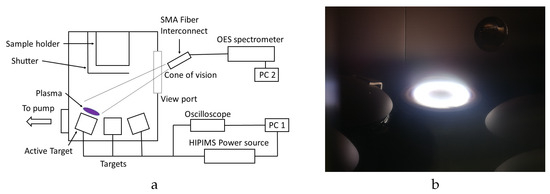
Figure 1
Highly Accessed Articles
Latest Books
E-Mail Alert
News
Topics
Topic in
Applied Sciences, JMMP, Materials, Photonics, Plasma
Hybrid and Heterogeneous Integration on Photonic Circuits
Topic Editors: Joan Manel Ramírez, Carlos Alberto Alonso-RamosDeadline: 31 May 2024
Topic in
Cancers, Catalysts, Current Oncology, Plasma, Sci
Advances in Low-Temperature Plasma Cancer Therapy
Topic Editors: Michael Keidar, Li Lin, Dayun YanDeadline: 20 September 2024

Conferences
Special Issues
Special Issue in
Plasma
New Insights into Plasma Theory, Modeling and Predictive Simulations
Guest Editor: Tariq RafiqDeadline: 30 April 2024
Special Issue in
Plasma
Processes in Atmospheric Pressure Plasmas
Guest Editors: Dariusz Z. Korzec, Maik FroehlichDeadline: 30 June 2024
Special Issue in
Plasma
Plasma and Artificial Intelligence
Guest Editors: Brunello Tirozzi, Orchidea LecianDeadline: 31 August 2024









